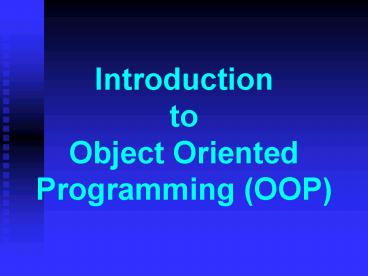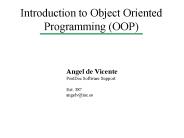Introduction to Object Oriented Programming OOP - PowerPoint PPT Presentation
1 / 17
Title:
Introduction to Object Oriented Programming OOP
Description:
mango, apple and orange are objects of the class Fruit. ... Fruit mango; Data Abstraction and Encapsulation. Basic Concepts of OOP (Cont. ... – PowerPoint PPT presentation
Number of Views:182
Avg rating:3.0/5.0
Title: Introduction to Object Oriented Programming OOP
1
IntroductiontoObject OrientedProgramming (OOP)
2
Introduction
- Many programming approaches have been tried to
handle complex problems
- modular programming
- top-down programming
- bottom-up programming
- structured programming
- Object Oriented Programming (OOP)
- latest programming approach to handles
problems
- Eliminate some of the pitfalls of conventional
programming
- Model real-world problems well
3
Procedure-Oriented Programming
- Use high level languages such as Pascal, C.
- Problem is viewed as a sequence of things to
be done
- reading
- calculating
- printing, etc.
- Functions are written to accomplish this task.
- Primary focus on functions.
- Very little attention to data that are being
used by various functions
4
Structure of procedure-oriented programs
5
Procedure-Oriented (Cont.)
- Drawbacks
- Global data more prone to unintentional change
- In large programs, difficult to identify what
data is used by which functions.
- In case of revising an external data
structure, need to revise all functions that
access the data
6
Procedure-Oriented (Cont.)
- Some characteristics
- Emphasis is on doing things (algorithms).
- Large programs are divided into smaller
programs known as functions.
- Most of the functions share global data.
- Data move openly around the system from
function to function.
- Functions transform data from one form to
another.
- Employs top-down approach in program design.
7
OOP Paradigm
- OOP
- treats data as critical factor in the program
development
- does not allow data to flow freely around the
system
- ties data to functions that operate on it
- protect data from accidental changes from
outside functions
- Decompose a problem into a number of entities
called objects (datafunctions).
- Data of an object can be accessed only
functions that bind to the object
- However, functions of one object can access
the functions of other object.
8
Organization of data and functions in OOP
9
Object-Oriented (Cont.)
- Some of the important features
- Emphasis is on data rather than procedure.
- Programs are divided into what are known as
objects.
- Data structures are designed such that they
characterize the objects.
- Functions that operate on the data of an
object are tied together in the data structure.
- Data is hidden and cannot be accessed by
external functions.
- Objects may communicate with each other
through functions.
- New data and functions can be easily added
whenever necessary.
10
Basic Concepts of OOP
- Objects
- Basic run-time entities
- May be a person, a place, or any item
- Problem analyzed in terms of objects and nature
of communication between them
- Objects should be chosen s.t. they match
closely with real-world object.
- Objects interact by sending messages to one
another.
- Customer object sends a message to Account
Object requesting current balance.
- They can interact without knowing each others
data and codes.
11
Representation of an object
12
Basic Concepts of OOP (Cont.)
- Classes
- Collection of similar objects
- Once a class has been defined, we can create
any number of objects belonging to that class.
- mango, apple and orange are objects of the
class Fruit.
- Classes are user-defined data types and behave
like built-in data types.
- Fruit mango
13
Basic Concepts of OOP (Cont.)
- Data Abstraction and Encapsulation
- Encapsulation - combing of the data and
functions into a single unit (called class)
- Data hiding data is not accessible to the
outside world (other classes)
- Data abstraction includes only features
relevant to the problem neglecting other
unnecessary details
14
Basic Concepts of OOP (Cont.)
- Inheritance
- Process by which objects of one class acquire
the properties of objects of another class.
- Reusability that we can add additional
features to an existing class without modifying
it
15
Basic Concepts of OOP (Cont.)
- Polymorphism
- Ability to take more than one form.
- The behavior depends on the types of data used
in operation.
16
Benefits of OOP
- Through inheritance, we can eliminate
redundant code and extend the use of existing
classes.
- We can build programs from standard working
modules rather than having to start from the
scratch. This leads to saving of development
time higher productivity.
- Data hiding helps the programmer to secure
programs that cannot be invaded by code in
other parts of the program.
- It is possible to map objects in the problem
domain to those objects in the program.
17
Benefits of OOP (Cont.)
- It is easy to partition the work in a project
based on objects.
- The data-centered design approach enables us
to capture more details of a model in
implementable form.
- Object-oriented systems can be easily upgraded
from small to large systems.
- Software complexity can be easily managed.































